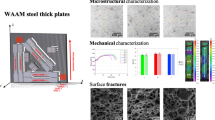Abstract
The project “Multi-Layer Inserts” (MLI) proposes a new design for inserts used in thin-walled CFRP structures. The proposed inserts consist of multiple thin metal sheets and is build up simultaneously with the laminate in an intrinsic hybridization process, eliminating time-consuming post-processing steps. Furthermore, at equal weight, such inserts greatly increase the bonding area between metal and CFRP in comparison to conventional inserts. This results in a significant increase of the loads that can be transmitted into the CFRP. The present work discusses how the shape of the metal sheets which the proposed inserts consist of influences the mechanical properties of the surrounding laminate. This influence is investigated by measuring the strain distribution during tensile tests by means of digital image correlation. The strain distributions around the following three different MLI design approaches are compared: An elliptical metal sheet, which is expected to be ideal in terms of mechanical performance of the overall structure; a cross-shape metal sheet representing a production-driven simplification which only requires the ability to perform cuts in individual tows perpendicular to the laying direction and can be performed by state-of-the-art AFP systems; and lastly, a compromise between manufacturability and achieved mechanical performance, a decagonal metal sheet design, which requires angled cuts of the fiber tows. It is shown, that the decagon is able to evenly spread the strain over a larger area and is therefore able to significantly reduce the maximum strain values compared to a cross-shape metal sheet, while still being automatable.











Similar content being viewed by others
Notes
The strain computation of one facet within the digital image correlation is based on the change of distance to the surrounding facets. To be independent of axis misalignments, e.g. of the camera and specimen axes, the strain tensor is computed. The direction of maximal strain is defined as major strain.
References
Banea MD, da Silva LFM (2009) Adhesively bonded joints in composite materials: an overview. Proc Inst Mech Eng Part L J Mater Des Appl 223(1):1–18
Bogetti TA, Gillespie JW, Lamontia MA (2016) Influence of ply waviness on the stiffness and strength reduction on composite laminates. J Thermoplast Compos Mater 5(4):344–369. https://doi.org/10.1177/089270579200500405
Schmidt F, Rheinfurth M, Horst P et al (2012) Effects of local fibre waviness on damage mechanisms and fatigue behaviour of biaxially loaded tube specimens. Compos Sci Technol 72(10):1075–1082. https://doi.org/10.1016/j.compscitech.2011.09.012
Camanho P, Tong L (2011) Composite joints and connections: principles, modelling and testing. Woodhead Publishing in materials. Woodhead Publishing, Cambridge
Ferret B, Anduze M, Nardari C (1998) Metal inserts in structural composite materials manufactured by RTM. Compos Part A Appl Sci Manuf 29(5–6):693–700. https://doi.org/10.1016/S1359-835X(97)00107-3
Grützner R, Stefaniak D, Koch SF et al. (2016) Intrinsic hybrid composites for lightweight structures: new process chain approaches. In: WGP congress 2016, vol 1140. Trans Tech Publications, pp 239–246
Schürmann H (2007) Konstruieren mit Faser-Kunststoff-Verbunden. Springer, Berlin
Volkersen O (1953) Die Schubkraftverteilung in Leim-, Niet-und Bolzenverbindungen. Energie Technik 5(68):103
Misseroni D, Dal Corso F, Shahzad S et al (2014) Stress concentration near stiff inclusions: validation of rigid inclusion model and boundary layers by means of photoelasticity. Eng Fract Mech 121:87–97
Herwig A, Woidt M, Horst P (2016) Comparison of one-, two- and three-dimensional models of a metallic insert in a composite. Key Eng Mater 713:175–178
Torres MM (2009) Cutting system for strips. World patent WO002009153370A1, 16 June 2009
He X (2014) Influence of boundary conditions on stress distributions in a single-lap adhesively bonded joint. Int J Adhes Adhes 53(Supplement C): 34–43. https://doi.org/10.1016/j.ijadhadh.2014.01.009
3M (2009) Scotch-Weld™ structural adhesive film—technical datasheet: AF 163–2
Acknowledgements
This paper is based on investigations of the subproject 1—‘Multilayer Inserts—intrinsic hybrid compounds for load introduction into thin walled high-performance CFRP-Structures’ (DE-447/123-1) of the priority program 1712 ‘Intrinsic hybrid composites for lightweight load-bearings’, which is kindly supported by the German Research Foundation (DFG).
Author information
Authors and Affiliations
Corresponding author
Rights and permissions
About this article
Cite this article
Groß, L., Herwig, A., Berg, D.C. et al. Production-based design of a hybrid load introduction element for thin-walled CFRP Structures. Prod. Eng. Res. Devel. 12, 113–120 (2018). https://doi.org/10.1007/s11740-018-0821-4
Received:
Accepted:
Published:
Issue Date:
DOI: https://doi.org/10.1007/s11740-018-0821-4




